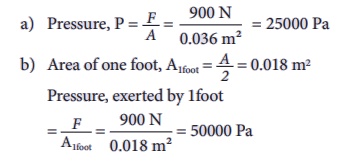Chapter: 9th Science : Fluids
Thrust and Pressure
Thrust
and Pressure
Try to fix a paper with
the help of a drawing pin. Push the pin into the board by its head. Did you
succeed? Try now to push the pin by the pointed end. Could you do it this time?
Have you ever wondered why a camel can run in a desert easily? Why a truck or a
motorbus has wider tyre? Why cutting tools have sharp edges? In order to answer
these questions and understand the phenomena involved, we need to learn about
two interrelated physical concepts called thrust and pressure.
In both the cases of the
above activity, the force exerted on the sand is the weight of your body which
is the same. This force acting perpendicular to the surface is called thrust.
When you stand on loose sand, the force is acting on an area equal to the area of
your feet. When you lie down, the same force acts on an area of your whole
body, which is larger than the area of your feet. Therefore the effect of
thrust, that is, pressure depends on the area on which it acts. The effect of
thrust on sand is larger while standing than lying.
The net force in a
particular direction is called thrust. The force per unit area acting on an
object concerned is called pressure. Thus, we can say thrust on an unit area is
pressure.
Pressure = Thrust/Area
of contact

For the same given
force, if the area is large pressure is low and vice versa. This is shown in
Figure 1.1.

In SI units, the unit of
thrust is newton denoted as N. The unit of pressure is newton per square metre
or newton metre–2 denoted as Nm–2. In the honour of the
great French scientist, Blaise Pascal, 1 newton per square metre is called as 1
pascal denoted as Pa. 1 Pa = 1 N m–2
In CGS system force is
measured in dyne and area in square cm. Thus the unit of pressure in CGS system
is dyne per square cm (dyne cm-2). The relation between the two
units is,
1 N m–2 = 10
dyne cm–2.
Example 1.1
A man whose mass is 90
kg stands on his feet on a floor. The
total area of contact of his two feet
with the floor is 0.036 m2.
(Take, g = 10 ms–2)
a. How much is the
pressure exerted by him on the floor?
b. What pressure will he
exert on the floor if he stands on one foot?
Solution
The weight of the man
(thrust),
F = mg = 90 kg × 10 ms–2
= 900 N

Related Topics